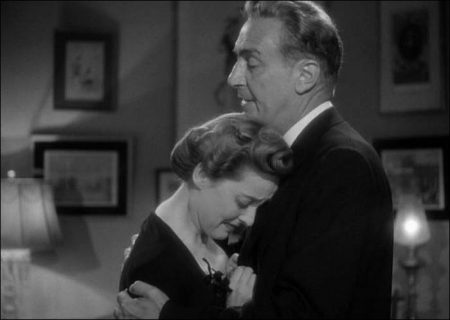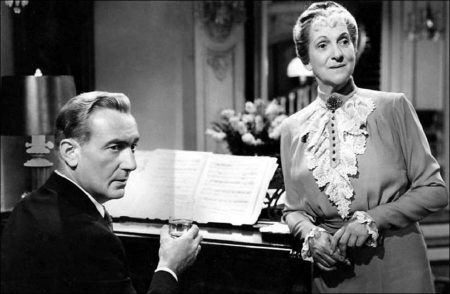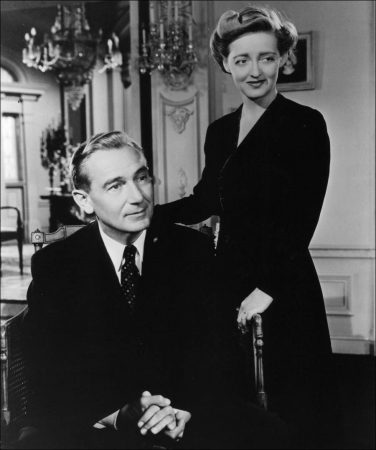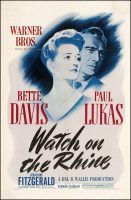Taglines: On her lonesome lips a smile.
Watch on the Rhine movie storyline. Anti-Fascist German engineer Kurt Muller, with his American-born wife, Sara, and their three children, returns to the United States in 1940 after spending 17 years in Europe, where Kurt has engaged in underground resistance to the rising Nazi threat. Unscrupulous Romanian count Teck de Brancovis, a houseguest of Sara’s family in Washington, D.C., discovers Kurt’s secret and threatens to expose his activities to his contacts at the German embassy.
Watch on the Rhine is a 1943 American drama film directed by Herman Shumlin and starring Bette Davis and Paul Lukas. The screenplay by Dashiell Hammett is based on the 1941 play Watch on the Rhine by Lillian Hellman. Watch on the Rhine was nominated for the Academy Award for Best Picture and Paul Lukas won the Academy Award for Best Actor for his performance as Kurt Muller, a German-born anti-fascist in this film.
About the Production
The Lillian Hellman play had enjoyed a respectable run of 378 performances on Broadway. Feeling its focus on patriotism would make it an ideal and prestigious propaganda film at the height of World War II, Jack L. Warner paid $150,000 for the screen rights.
Because Bette Davis was involved with Now, Voyager, producer Hal B. Wallis began searching for another actress for the role of Sara Muller while Hellman’s lover Dashiell Hammett began writing the screenplay at their farm in Pleasantville, New York. Irene Dunne liked the material but felt the role was too small, and Margaret Sullavan expressed no interest whatsoever. Edna Best, Rosemary DeCamp, and Helen Hayes also were considered.
For the role of Kurt Muller, Wallis wanted Charles Boyer. He, however, felt his French accent was wrong for the character, so the producer decided to cast Paul Lukas, who had originated the role on Broadway and had been honored by The Drama League for his performance.
Paul Henreid later said Jack Warner offered him the lead but turned it down because he did not want to be typecast, and felt that it was based on a “contrived play, in no way up to Elmer Rice’s Flight to the West. My original contract stipulated that I always get the girl and I used that as an excuse to get out of the movie.”
Meanwhile, Hammett was sidelined by an injured back, and by the time he was ready to resume work on the script, Davis was close to completing her work in Now, Voyager. Wallis sent Davis, a staunch supporter of Franklin D. Roosevelt and a fierce opponent of the Nazi Party, the screenplay-in-progress, and she immediately accepted the offer.
With Davis cast as Sara, Wallis encouraged Hammett to embellish what essentially was a secondary role to make it worthy of the leading lady’s status as a star, and to open the story by adding scenes outside the Farrelly living room, which had been the sole setting on stage.
The Production Code Administration was concerned that Kurt Muller escaped prosecution for his murder of Teck de Brancovis, and the Hays Office suggested it be established Kurt was killed by the Nazis at the end of the film in order to show he paid for his crime. Hellman objected, the studio agreed Kurt had been justified in shooting Teck, and the scene remained.
In his afterword to the April 25, 2020 airing of Watch on the Rhine on TCM, Dave Karger describes this controversy in more detail. According to Karger’s script, Joe Breen demanded a new scene in which Muller suffered the consequences of his actions, but Lukas did not show up for the filming. The censor insisted that Muller could not be allowed to get away with murder, even of a Nazi, so the last scene of the film, between Sara and her son, Joshua, was added. Many months have passed without word from Muller, strongly suggesting that he has been captured and/or killed.
Filming began on June 9, 1942, and did not go smoothly. Beginning only a week after Now, Voyager had ended production, Davis was working without a substantial vacation and was on edge. As a result, she immediately clashed with Herman Shumlin, who had directed the play but had no experience in film, and she tended to ignore his suggestions.
Her emotional overacting prompted Wallis to send Shumlin numerous memos urging the director to tone down her performance. Shumlin threatened to quit because he was unhappy with cinematographer Merritt B. Gerstad, who eventually was replaced by Hal Mohr in order to appease the director. Meanwhile, Davis also was at odds with Lucile Watson who was reprising the role of the mother she had portrayed on stage, because Watson was a Republican whose political views sharply contrasted with those of the Democratic Davis. She and Lukas, however, got along quite well.
Several exterior scenes shot on location in Washington were cut from the film before its release due to wartime restrictions on the filming of government buildings.
When Wallis announced he was giving Davis top billing, she argued it was ridiculous to do so given hers was a supporting role. The studio’s publicity department argued it was her name that would attract an audience, and despite her resistance, the film’s credits and all promotional materials listed her first.
Davis and Lukas reprised their roles for a radio adaptation that aired in the January 10, 1944 broadcast of The Screen Guild Theater.
Awards and Nominations
The film won the New York Film Critics Circle Award for Best Picture.
It was also nominated for the Academy Award for Best Picture.
Paul Lukas won the Academy Award for Best Actor, the Golden Globe Award for Best Actor – Motion Picture Drama (the first time the award was presented), and the New York Film Critics Circle Award for Best Actor.
Lucile Watson was nominated for the Academy Award for Best Supporting Actress but lost to Katina Paxinou in For Whom the Bell Tolls. Dashiell Hammett was nominated for the Academy Award for Best Writing (Adapted Screenplay) but lost to the trio of Philip G. Epstein, Julius J. Epstein, and Howard Koch, who won for the work in Casablanca.
Watch on the Rhine (1943)
Directed by: Herman Shumlin
Starring: Bette Davis, Paul Lukas, Lucile Watson, Geraldine Fitzgerald, George Coulouris, Beulah Bondi, Donald Woods, Donald Buka, Janis Wilson, Eric Roberts, Mary Young, Anthony Caruso
Screenplay by: Dashiell Hammett
Production Design by: Chuck Hansen
Cinematography by: Merritt B. Gerstad, Hal Mohr
Film Editing by: Rudi Fehr
Costume Design by: Orry-Kelly
Set Decoration by: Julia Heron
Art Direction by: Carl Jules Weyl
Music by: Max Steiner
MPAA Rating: None.
Distributed by: Warner Bros. Pictures
Release Date: August 27, 1943
Visits: 154



